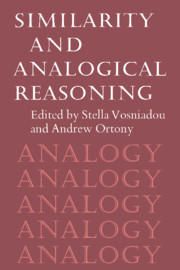Book contents
- Frontmatter
- Contents
- Preface
- List of contributors
- Similarity and analogical reasoning: a synthesis
- Part I Similarity and the structure of concepts
- 1 Similarity, typicality, and categorization
- 2 Similarity and decision making
- 3 Intraconcept similarity and its implications for interconcept similarity
- 4 Two-tiered concept meaning, inferential matching, and conceptual cohesiveness
- 5 From global similarities to kinds of similarities: the construction of dimensions in development
- 6 Comments on Part I: Psychological essentialism
- Part II Analogical reasoning
- Part III Similarity and analogy in development, learning, and instruction
- Afterword: Comments on Parts I, II, and III: A framework for a theory of comparison and mapping
- Name index
- Subject index
3 - Intraconcept similarity and its implications for interconcept similarity
Published online by Cambridge University Press: 22 October 2009
- Frontmatter
- Contents
- Preface
- List of contributors
- Similarity and analogical reasoning: a synthesis
- Part I Similarity and the structure of concepts
- 1 Similarity, typicality, and categorization
- 2 Similarity and decision making
- 3 Intraconcept similarity and its implications for interconcept similarity
- 4 Two-tiered concept meaning, inferential matching, and conceptual cohesiveness
- 5 From global similarities to kinds of similarities: the construction of dimensions in development
- 6 Comments on Part I: Psychological essentialism
- Part II Analogical reasoning
- Part III Similarity and analogy in development, learning, and instruction
- Afterword: Comments on Parts I, II, and III: A framework for a theory of comparison and mapping
- Name index
- Subject index
Summary
A permanently existing “idea” or “Vorstellung” which makes its appearance before the footlights of consciousness at periodic intervals, is as mythological an entity as the Jack of Spades.
William James, 1890/1950, p. 236A central goal of cognitive science is to characterize the knowledge that underlies human intelligence. Many investigators have expended much effort toward this aim and in the process have proposed a variety of knowledge structures as the basic units of human knowledge, including definitions, prototypes, exemplars, frames, schemata, scripts, and mental models. An implicit assumption in much of this work is that knowledge structures are stable: Knowledge structures are stored in long-term memory as discrete and relatively static sets of information; they are retrieved intact when relevant to current processing; different members of a population use the same basic structures; and a given individual uses the same structures across contexts. These intuitions of stability are often compelling, and it is sometimes hard to imagine how we could communicate or perform other intelligent behaviors without stable knowledge structures.
But perhaps it is important to consider the issue of stability more explicitly. Are there stable knowledge structures in long-term memory? If so, are they retrieved as static units when relevant to current processing? Do different individuals represent a given category in the same way? Does a given individual represent a category the same way across contexts? Whatever conclusions we reach should have important implications for theories of human cognition and for attempts to implement increasingly powerful forms of machine intelligence.
- Type
- Chapter
- Information
- Similarity and Analogical Reasoning , pp. 76 - 121Publisher: Cambridge University PressPrint publication year: 1989
- 82
- Cited by

